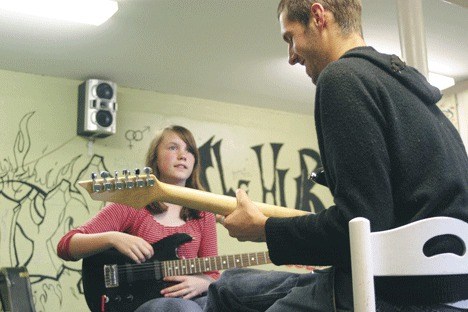For the first time in 21 years, the after-school drop-in center for teens in Langley is closing before the end of the school year for lack of money.
The closure of the South Whidbey Youth Connection’s Hub is the latest indication that the sour economy is hitting local nonprofits hard, as other organizations also battle with increasing needs and dwindling funds.
“We feel bad closing three weeks early,” said Duane Gimbel, director of the nonprofit South Whidbey Youth Connection, which runs the program for middle and high school students in the basement of Langley United Methodist Church.
Summer field trips and other activities sponsored by the Hub also will be dropped this year, Gimbel said.
“It was a tough decision,” Gimbel said Thursday. “There’s not a lot of after-school options here for teens.”
Friday was the Hub’s last day of operation.
Gimbel is optimistic that the program will reopen on Sept. 7, the first day of the new school year, if new grants come through and planned fundraisers are productive.
“Hopefully, this is only a temporary glitch,” he said. “We have every intention to keep going.”
Other area nonprofit officials also are worried about their programs.
“We’re all hurting,” said Doris Newkirk, director of Whidbey Island Share a Home (WISH), which matches the homeless with local residents who will take them in.
“We all ask the same people for help,” Newkirk said Thursday of the area’s nonprofit groups, “and the pie’s been getting smaller and smaller the past couple of years.”
“Unless the economy can turn around, it’s only going to get worse,” she predicted.
In Langley, the Hub has offered free lunches, games, activities, music lessons — “all kinds of stuff,” Gimbel said —- for students who drop by after school during the week.
He said that there was a 200-percent increase in teen visits to the Hub in the past year. About 300 students annually take advantage of the program, an average of 30 per day, he added.
Gimbel said the program’s primary source of funding has been a yearly grant from the state Community Mobilization Against Substance Abuse and Violence, which for the current fiscal year provided $55,000.
That amount will be reduced to $14,000 in July, by action of the state Legislature, Gimbel said.
Additional funding for the program includes $17,500 from United Way, which he hopes will continue, and from donations and fundraising events, Gimbel said.
He said it costs about $10,000 per month to run the Hub. Most of the money goes for food, activities, salaries and funding for instructors, he said. The church provides its basement space for free.
“We’re busy writing grants and planning fundraising events,” Gimbel said. “We hope to be on firmer ground next year.”
Other area organizations also are trying to keep their feet on the ground.
Kathy McLaughlin, director of the Good Cheer Food Bank in Bayview, said Thursday that donations for this year are down $30,000 from the previous year, a 48-percent decrease. Meanwhile, demand keeps climbing.
She said the food bank served 795 families in April, compared to 667 families in April 2009. She said the organization has spent nearly 37 percent more on food this year to keep up with demand, forcing some tough decisions.
“In other words, the families we serve will be receiving less,” McLaughlin said. “We have no other choice.”
Rosemary Martin of Helping Hand tells a similar story. The nonprofit assists South Whidbey residents who have trouble meeting rent, heat, power and other essential expenses.
Dependent entirely on donations, her group’s income has declined only slightly, but the demand is way up.
“People come to our door every day,” she said. “We’re where people turn when they have no where else to turn.”
“We’ve really cut back,” Martin continued. “We try to make the best of the money we have.”
As a member of the Help Network, an umbrella organization made up of directors of the island’s 15 to 20 nonprofits, most on the South End, she hears the same story being repeated again and again.
“If the economy continues the way it is, some of these groups will probably cease to exist,” Martin said.
And as for Good Cheer, one of the most visible and well-organized nonprofits on South Whidbey, Martin said: “If they’re down, the rest of us are really in trouble.”
Cheryn Weiser, director of Senior Services of Island County, also paints a picture of decreased resources and increased demand.
Contacts for help have increased 25 percent, she said Friday. In-home nursing services have been cut by 90 percent, other in-home services by as much as 40 percent and caregiver services have been significantly reduced, Weiser said.
Meanwhile, the cost of food for on-site meals and Meals on Wheels has increased from 6 to 11 percent, she said.
Weiser said 18 percent of the island’s population is currently over age 65; by 2030, that figure will be more than 30 percent.
“Our numbers are going to continue to go up, while funding mechanisms are going to become more constrained,” she said. “Things are going to get tighter.”
Newkirk of WISH said there has been a “dramatic decrease” in donations this year, at the same time requests for housing help have more than doubled. She said WISH received 1,200 requests for assistance in the past year.
Newkirk said that according to school district records, 200 children on Whidbey Island are homeless.
“They’re living in cars, doubling up with neighbors, living with relatives,” she said. “They don’t have an address to call their own.”



